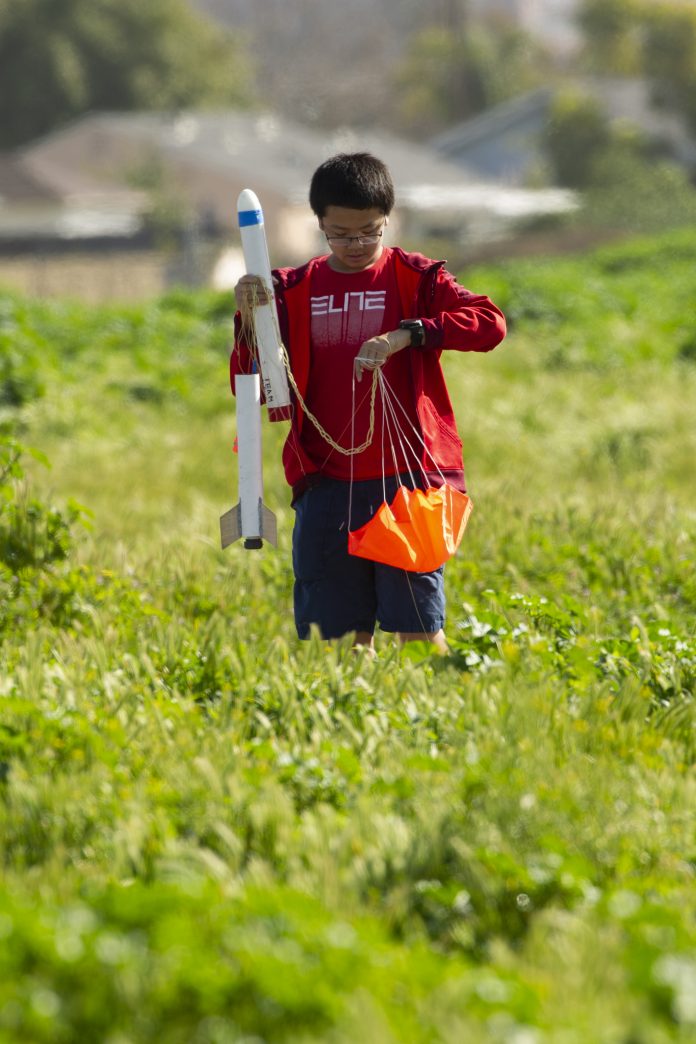
by Senior Airman Crystal Housman, California National Guard Public Affairs
Students in the STARBASE Los Alamitos STARBASE 2.0 program counted down from five and turned their eyes toward the sky, March 13, over Joint Forces Training Base Los Alamitos, California, during the second set of practice launches for their entry into this year’s Team America Rocketry Challenge (TARC) competition.
The program’s middle-school-aged aerospace engineers are vying for a chance to take their custom-built rockets to Virginia for the TARC National Finals Fly Off in May. TARC is the largest rocketry competition for middle school and high school students nationwide and U.S. winners go on to a worldwide competition.
“It’s a really big deal and we’re really hoping to get there,” said seventh grader and second-year competitor Gina Rodeghiero, 13, of La Habra. “If we can take it to the next level that would be amazing.”
Rodeghiero and her teammates began designing this year’s competition rockets in September using computer aided design software and a rocket simulator. By January, she said, they were in the building phase.
To make the national competition, the team will first have to record a pair of successful qualifying rocket launches that shoot into the sky, deploy multiple parachutes and safely land without cracking the raw eggs encapsulated inside.
If the eggs are intact and the flight is deemed a successful qualifier, the launch is then scored by TARC judges based on its closeness to predetermined altitude and total flight duration targets set forth for the competition.
This year’s theme commemorates the 50th anniversary of the U.S. space program’s Apollo 11, which made the first lunar landing in June 1969.
According to the 2019 TARC handbook, competing rockets must carry three eggs as payload, which is symbolic to the three astronauts – Neil Armstrong, Edwin “Buzz” Aldrin, and Michael Collins – who made the historic mission. The rockets should target an altitude of 856 ft., it outlines, in honor of the time, 8:56 p.m., that Armstrong first stepped on the moon as recorded by clocks in Houston, Texas, where NASA personnel were tracking the mission.
TARC targets and rocket specifications change each year, said Rodeghiero, who plans to pursue an engineering career in rockets or robotics.
“It’s a lot more challenging,” she said. “Last year we had two eggs which didn’t weigh that much, and this year we have three eggs. Last year we had one parachute and this year we have three parachutes.”
This year’s rockets must split apart after launch and land in two sections with at least two parachutes on the part carrying the eggs, the handbook dictates.
Packing and deploying multiple parachutes has been a new experience for the team, Rodeghiero said, but they are figuring it out.
“It’s trial and error. We come up with an idea and then we try it and then we learn from the mistakes,” she said.
After parachutes tangled during the first practice launch in early March, the team reversed how it loaded them into the rocket’s body. During Wednesday’s second practice launch, the parachutes came down more even more tangled.
“The changes were not good,” Rodeghiero said, “but we learned from it.”
In addition to the parachute system, the teen rocket scientists are also dialing in which rocket motor they will use for competition, how much additional weight they will place inside the body, and they are making body modifications to give the rocket’s altimeter more ventilation so it can give a more accurate reading.
“Everytime you gain something in one place you give it up someplace else,” said Tim Ziesmer, a STARBASE Los Alamitos instructor who also serves as the rocketry team’s coach. “Every advantage is a disadvantage.”
The team has until the first week of April to conduct three official qualification launches in front of TARC judges and at least two must be successful to be scored. The lowest two of the three scores are submitted for national fly off consideration.
Qualifying launches receive points for every foot of altitude they fly over or under the target goal and also receive points for every second they fly more or less than a three second flight duration window of 43 to 46 seconds.
Much like golf, the lower the score, the better.
The top 100 teams with the lowest qualifying launch scores from around the country receive invitations to the National Finals.
“With TARC, if you win, you’re right there at the finals,” Ziesmer said.
In 2016, STARBASE Los Alamitos fielded an unofficial team to try rocketry and determine if building a TARC program was a realistic goal. In 2017, one of the team’s rockets exploded on the launchpad and only one qualifying launch was recorded.
Last year, one of STARBASE Los Alamitos’ two teams missed the top 100 cutoff by one point.
“If we had .6 seconds better [flight time] or three feet better [altitude] either one would have put us in the final 100,” Zeismer said. “We were that close.”
It is rocket science, after all, and both the team and its coach keep coming back for more.
“I love the challenge,” Zeismer said. “When you build a rocket from scratch and you hit that button then it takes off and it works… there’s just nothing like it.”
Rodeghiero believes the team has a good chance at making nationals this year.
“I think we do,” she said. “We just need to be sure to stay focused and put in the time and work for it.
STARBASE is a Department of Defense program that focuses on inspiring youth to gain an interest in science, technology, engineering and math (STEM). The program, which primarily delivers hands-on STEM education to elementary school students at campuses around the country, also offers a voluntary afterschool 2.0 program for STARBASE graduates to further pursue STEM interests.
STARBASE Los Alamitos is one of three STARBASE programs in California and one of two STARBASE campuses facilitated by the California Military Department’s Youth and Community Programs Task Force.
